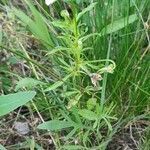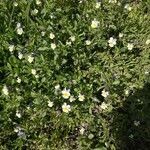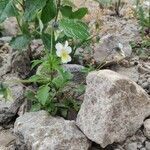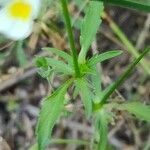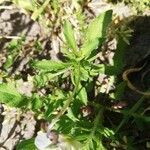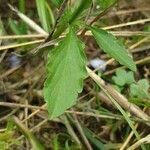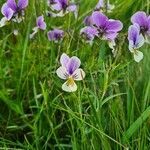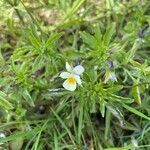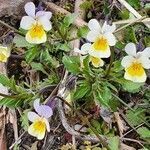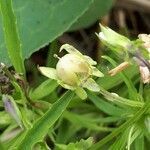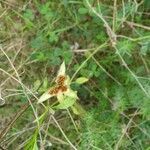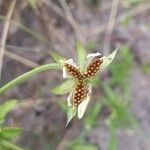Herbs annual or biennial, 5-50 cm tall. Stems erect to ascending, simple or with ascending branches from base, very sparsely puberulous. Stipules 2-40 mm, pinnatipartite, terminal segments largest, often leaflike, lateral ones linear to narrowly lanceolate; leaf blade 0.5-6.5 × 0.2-2.2 cm, sparsely puberulous, especially so along margin and along veins abaxially, margin crenate or serrate; lower leaves ovate or orbicular-ovate, base rounded, petioles equaling or exceeding blades; middle leaves oblong-ovate or oblong-elliptic, base cuneate, decurrent into a short petiole; upper leaves oblong-lanceolate, with indistinct petioles. Flowers few to numerous; pedicels 2.5-11 cm, glabrous, 2-bracteolate; bracteoles lanceolate. Sepals oblong-lanceolate, 4-15 mm, apex acute; basal auricles 1-4 mm, irregularly toothed. Corolla funnelform; petals yellow or ivory, obviously shorter than or nearly equaling sepals, 6-14 mm, upper ones pale, anterior one including spur 5.5-14 mm; spur 1-4 mm, not exceeding appendages, straight. Capsule 6-10 mm. Seeds oblong-ovoid, 1.5-1.8 mm. Fl. Apr-Sep, fr. Jun-Sep. 2n = 34.
Annual, with short-lived rosette; stems erect or ascending, with short hairs or glabrous, 7-30 cm tall. Lvs (1)-2-6 cm long, glabrous or with short hairs, with 3-7 crenations each side. Basal lvs broadly ovate, truncately narrowed to long petiole; stipules short, linear-lobed. Stem lvs becoming narrow-elliptic, the uppermost cuneately narrowed to short petiole; stipules usually pinnatifid, 1/2-3/4 lf length, with leaflike terminal lobe, and 3-7 linear lateral lobes. Peduncles erect, glabrous; bracts short, narrowly triangular. Fls 1-2.5 cm diam. Sepals narrowly triangular, acute, 5-8 mm long; appendages 2-3 mm long. Petals cream, the upper < or = the upper sepals, the lowest with yellow or orange blotch and purple veins, the lowest and lateral bearded; spur c. 3 mm long, = sepal appendages. Style geniculate at base, 1 mm long; stigma globose; ligule 0. Capsule ellipsoid, glabrous, 5-10 mm long. Seeds oblong, pale brown, 1.5 mm long.
Pubescent to glabrate annual to 30 cm, often branched from the base, the stem relatively robust, with short, reflexed hairs on the angles; lvs variable, the lowest orbicular to ovate, the upper oblong to elliptic or narrowly elliptic, all crenate; stipules foliaceous, laciniate into 5–9 slender segments and usually 1 lf-like segment often nearly as large as the main blade; fls 1–1.5 cm long, scarcely 1 cm wide; pet shorter than or barely equaling the broadly lanceolate sep, all pale yellow (“ivory”) or occasionally with purplish tips; spur short; style as in no. 27 [Viola rafinesquii Greene]; cleistogamous fls wanting; frs globose to ellipsoid, 5–10 mm; seeds brown; 2n=34. Native of Europe, now established as a weed in or near fields or along roadsides throughout our range and s. and w. Apr.–Sept.
Annual or biennial herb with decumbent, angular stems, sparsely pubescent. Leaves cauline; lamina broadly ovate to narrowly elliptic, obtuse, 10–35 mm long, 5–15 mm wide, obtusely serrate to crenate; petiole 10–20 mm long; stipules to 4 cm long, pinnately lobed, the midlobe toothed, leaf-like. Flower-scapes 3–8 cm long; bracteoles just below flower. Sepals lanceolate, acute to acuminate, 6–10 mm long, ciliate, with prominent basal appendages. Petals 5–10 mm long, the anterior shortly spurred, creamy white with yellow-orange base and sometimes variable amounts of violet; upper petals pale violet. Anthers ciliate. Style globose, with or without a stylar flap. Capsule trigonous, 5–9 mm long. Seed c. 1.5 mm long, golden-brown; aril very small.
Annual herb, up to 0.3 m high. Leaves oblong-spathulate, up to 50 mm long, pubescent both sides, apex acute or obtuse, margins crenate; petioles with deflexed hairs, up to 7 mm long; stipules 0.50-0.75X as long as leaf, coarsely pinnatifid. Flowers with bracts in upper 1/3 of peduncle, axillary. Sepals lanceolate, subequal. Petals yellow to bluish violet, up to 15 mm long; spur equaling calycine appendages. Stamens with very short, free filaments; anthers with nectariferous appendages, petaloid. Ovary unilocular with 3 parietal placentas, stigma terminal. Flowering time Oct.-Dec. Fruit a 3-lobed capsule. Seeds globose, pointed below and above.
A herb. It grows for one or two years. It grows 5-50 cm tall. The leaves are 1-7 cm long by 1-2 cm wide. They have some hairs especially along the edges and veins. There are some teeth along the edge. There can be a few or many flowers. They are funnel shaped and yellow.
